The ask: How do I get the viewing rectangle in the coordinates of a transformed and scaled node?
The code is attached below, it is based upon the code from this answer: JavaFX 8 Dynamic Node scaling
The details:
I have a simple pane, BigGridPane that contains a collection of squares, all 50x50.
I have it within this PanAndZoomPane construct that was lifted from the answer referenced above. I can not honestly say I fully understand the PanAndZoomPane implementation. For example, it's not clear to me why it needs a ScrollPane at all, but I have not delved in to trying without it.
The PanAndZoomPane lets me pan and zoom my BigGridPane. This works just dandy.
There are 4 Panes involved in this total construct, in this heirarchy: ScrollPane contains PanAndZoomPane which contains Group which contains BigGridPane.
ScrollPane
PanAndZoomPane
Group
BigGridPane
I have put listeners on the boundsInLocalProperty and boundsInParentProperty of all of these, and the only one of these that changes while panning and zooming, is the boundsInParentProperty of the PanAndZoomPane. (For some reason I've seen it trigger on the scroll pane, but all of the values are the same, so I don't include that here).
Along with the boundsInParentProperty changes, the translateX, translateY, and myScale properties of the PanAndZoomPane change as things move around. This is expected, of course. myScale is bound to the scaleX and scaleY properties of the PanAndZoomPane.
This is what it looks like at startup.

If I pan the grid as shown, putting 2-2 in the upper left:

We can see the properties of the PanAndZoomPane.
panAndZoom in parent: BoundingBox [minX:-99.5, minY:-99.5, minZ:0.0,
width:501.5, height:501.5, depth:0.0,
maxX:402.0, maxY:402.0, maxZ:0.0]
paz scale = 1.0 - tx: -99.0 - ty: -99.0
Scale is 1 (no zoom), and we've translated ~100x100. That is, the origin of the BigGridPane is at -100,-100. This all makes complete sense. Similarly, the bounding box shows the same thing. The origin is at -100,-100.
In this scenario, I would like to derive a rectangle that shows me what I'm seeing in the window, in the coordinates of the BigGridPane. That would mean a rectangle of
x:100 y:100 width:250 height:250
Normally, I think, this would be the viewport of the ScrollPane, but since this code isn't actually using the ScrollPane for scrolling (again, I'm not quite exactly what it's role is here), the ScrollPane viewport never changes.
I should note that there are shenanigans happening right now because of the retina display on my mac. If you look at the rectangles, showing 5x5, they're 50x50 rectangles, so we should be seeing 10x10, but because of the retina display on my iMac, everything is doubled. What we're seeing in BigGridPane coordinates is a 250x250 block of 5 squares, offset by 100x100. The fact that this is being showing in a window of 500x500 is a detail (but unlikely one we can ignore).
But to reiterate what my question is, that's what I'm trying to get: that 250x250 square at 100x100.
It's odd that it's offset by 100x100 even though the frame is twice as big (500 vs 250). If I pan to where 1-1 is the upper left, the offset is -50,-50, like it should be.
Now, let's add zooming, and pan again to 2-2.
1 click of the scroll wheel and the scale jumps to 1.5.

panAndZoom in parent: BoundingBox [minX:-149.375, minY:-150.375, minZ:0.0,
width:752.25, height:752.25, depth:0.0,
maxX:602.875, maxY:601.875, maxZ:0.0]
paz scale = 1.5 - tx: -23.375 - ty: -24.375
What I want, again, in this case, is a rectangle in BigGridPane coordinates. Roughly:
x:100 y:100 w:150 h:150
We see we're offset by 2x2 boxes (100x100) and we see 3+ boxes (150x150).
So. Back to the bounding box. MinX and minY = -150,-150. This is good. 100 x 1.5 = 150. Similarly the width and height are 750. 500 x 1.5 = 750. So, that is good.
The translates are where we go off the rails. -23.375, -24.375. I have no idea where these numbers come from. I can't seem to correlate them to anything in regards to 100, 150, 1.5 zoom, etc.
Worse, if we pan (while still at 1.5 scale) to "0,0", before, at scale=1, tx and ty were both 0. That's good.
panAndZoom in parent: BoundingBox [minX:0.625, minY:0.625, minZ:0.0,
width:752.25, height:752.25, depth:0.0,
maxX:752.875, maxY:752.875, maxZ:0.0]
paz scale = 1.5 - tx: 126.625 - ty: 126.625
Now, they're 126.625 (probably should be rounded to 125). I have no idea where those numbers come from.
I've tried all sorts of runs on the numbers to see where these numbers come from.
JavaFX knows what the numbers are! (even if the whole retina thing is kind of messing with my head, I'm going to ignore it for the moment).
And I don't see anything in the transforms of any of the panes.
So, my coordinate systems are all over the map, and I'd like to know what part of my BigGridPane is being shown in my panned and scaled view.
Code:
package pkg;
import javafx.animation.KeyFrame;
import javafx.animation.KeyValue;
import javafx.animation.Timeline;
import javafx.application.Application;
import javafx.beans.property.DoubleProperty;
import javafx.beans.property.SimpleDoubleProperty;
import javafx.collections.ObservableList;
import javafx.event.EventHandler;
import javafx.geometry.Bounds;
import javafx.geometry.Point2D;
import javafx.scene.Group;
import javafx.scene.Node;
import javafx.scene.Scene;
import javafx.scene.control.Label;
import javafx.scene.control.ScrollPane;
import javafx.scene.input.MouseEvent;
import javafx.scene.input.ScrollEvent;
import javafx.scene.layout.AnchorPane;
import javafx.scene.layout.BorderPane;
import javafx.scene.layout.Pane;
import javafx.scene.layout.Region;
import javafx.scene.paint.Color;
import javafx.scene.shape.Rectangle;
import javafx.scene.text.Font;
import javafx.scene.text.Text;
import javafx.stage.Stage;
import javafx.util.Duration;
public class PanZoomTest extends Application {
private ScrollPane scrollPane = new ScrollPane();
private final DoubleProperty zoomProperty = new SimpleDoubleProperty(1.0d);
private final DoubleProperty deltaY = new SimpleDoubleProperty(0.0d);
private final Group group = new Group();
PanAndZoomPane panAndZoomPane = null;
BigGridPane1 bigGridPane = new BigGridPane1(10, 10, 50);
@Override
public void start(Stage primaryStage) throws Exception {
scrollPane.setPannable(true);
scrollPane.setHbarPolicy(ScrollPane.ScrollBarPolicy.NEVER);
scrollPane.setVbarPolicy(ScrollPane.ScrollBarPolicy.NEVER);
group.getChildren().add(bigGridPane);
panAndZoomPane = new PanAndZoomPane();
zoomProperty.bind(panAndZoomPane.myScale);
deltaY.bind(panAndZoomPane.deltaY);
panAndZoomPane.getChildren().add(group);
SceneGestures sceneGestures = new SceneGestures(panAndZoomPane);
scrollPane.setContent(panAndZoomPane);
panAndZoomPane.toBack();
addListeners("panAndZoom", panAndZoomPane);
scrollPane.addEventFilter(MouseEvent.MOUSE_PRESSED, sceneGestures.getOnMousePressedEventHandler());
scrollPane.addEventFilter(MouseEvent.MOUSE_DRAGGED, sceneGestures.getOnMouseDraggedEventHandler());
scrollPane.addEventFilter(ScrollEvent.ANY, sceneGestures.getOnScrollEventHandler());
AnchorPane anchorPane = new AnchorPane();
anchorPane.getChildren().add(scrollPane);
anchorPane.setTopAnchor(scrollPane, 1.0d);
anchorPane.setRightAnchor(scrollPane, 1.0d);
anchorPane.setBottomAnchor(scrollPane, 1.0d);
anchorPane.setLeftAnchor(scrollPane, 1.0d);
BorderPane root = new BorderPane(anchorPane);
Label label = new Label("Pan and Zoom Test");
root.setTop(label);
Scene scene = new Scene(root, 250, 250);
primaryStage.setScene(scene);
primaryStage.show();
}
public static void main(String[] args) {
launch(args);
}
private void addListeners(String label, Node node) {
node.boundsInLocalProperty().addListener((o) -> {
System.out.println(label + " in local: " + node.getBoundsInLocal());
});
node.boundsInParentProperty().addListener((o) -> {
System.out.println(label + " in parent: " + node.getBoundsInParent());
System.out.println("paz scale = " + panAndZoomPane.getScale() + " - "
+ panAndZoomPane.getTranslateX() + " - "
+ panAndZoomPane.getTranslateY());
System.out.println(group.getTransforms());
});
}
class BigGridPane extends Region {
int rows;
int cols;
int size;
Font numFont = Font.font("sans-serif", 8);
FontMetrics numMetrics = new FontMetrics(numFont);
public BigGridPane(int cols, int rows, int size) {
this.rows = rows;
this.cols = cols;
this.size = size;
int sizeX = cols * size;
int sizeY = rows * size;
setMinSize(sizeX, sizeY);
setMaxSize(sizeX, sizeY);
setPrefSize(sizeX, sizeY);
populate();
}
@Override
protected void layoutChildren() {
System.out.println("grid layout");
super.layoutChildren();
}
private void populate() {
ObservableList<Node> children = getChildren();
children.clear();
for (int i = 0; i < cols; i++) {
for (int j = 0; j < rows; j++) {
Rectangle r = new Rectangle(i * size, j * size, size, size);
r.setFill(null);
r.setStroke(Color.BLACK);
String label = i + "-" + j;
Point2D p = new Point2D(r.getBoundsInLocal().getCenterX(), r.getBoundsInLocal().getCenterY());
Text t = new Text(label);
t.setX(p.getX() - numMetrics.computeStringWidth(label) / 2);
t.setY(p.getY() + numMetrics.getLineHeight() / 2);
t.setFont(numFont);
children.add(r);
children.add(t);
}
}
}
}
class PanAndZoomPane extends Pane {
public static final double DEFAULT_DELTA = 1.5d; //1.3d
DoubleProperty myScale = new SimpleDoubleProperty(1.0);
public DoubleProperty deltaY = new SimpleDoubleProperty(0.0);
private Timeline timeline;
public PanAndZoomPane() {
this.timeline = new Timeline(30);//60
// add scale transform
scaleXProperty().bind(myScale);
scaleYProperty().bind(myScale);
}
public double getScale() {
return myScale.get();
}
public void setScale(double scale) {
myScale.set(scale);
}
public void setPivot(double x, double y, double scale) {
// note: pivot value must be untransformed, i. e. without scaling
// timeline that scales and moves the node
timeline.getKeyFrames().clear();
timeline.getKeyFrames().addAll(
new KeyFrame(Duration.millis(200), new KeyValue(translateXProperty(), getTranslateX() - x)), //200
new KeyFrame(Duration.millis(200), new KeyValue(translateYProperty(), getTranslateY() - y)), //200
new KeyFrame(Duration.millis(200), new KeyValue(myScale, scale)) //200
);
timeline.play();
}
public double getDeltaY() {
return deltaY.get();
}
public void setDeltaY(double dY) {
deltaY.set(dY);
}
}
/**
* Mouse drag context used for scene and nodes.
*/
class DragContext {
double mouseAnchorX;
double mouseAnchorY;
double translateAnchorX;
double translateAnchorY;
}
/**
* Listeners for making the scene's canvas draggable and zoomable
*/
public class SceneGestures {
private DragContext sceneDragContext = new DragContext();
PanAndZoomPane panAndZoomPane;
public SceneGestures(PanAndZoomPane canvas) {
this.panAndZoomPane = canvas;
}
public EventHandler<MouseEvent> getOnMousePressedEventHandler() {
return onMousePressedEventHandler;
}
public EventHandler<MouseEvent> getOnMouseDraggedEventHandler() {
return onMouseDraggedEventHandler;
}
public EventHandler<ScrollEvent> getOnScrollEventHandler() {
return onScrollEventHandler;
}
private EventHandler<MouseEvent> onMousePressedEventHandler = new EventHandler<MouseEvent>() {
public void handle(MouseEvent event) {
sceneDragContext.mouseAnchorX = event.getX();
sceneDragContext.mouseAnchorY = event.getY();
sceneDragContext.translateAnchorX = panAndZoomPane.getTranslateX();
sceneDragContext.translateAnchorY = panAndZoomPane.getTranslateY();
}
};
private EventHandler<MouseEvent> onMouseDraggedEventHandler = new EventHandler<MouseEvent>() {
public void handle(MouseEvent event) {
panAndZoomPane.setTranslateX(sceneDragContext.translateAnchorX + event.getX() - sceneDragContext.mouseAnchorX);
panAndZoomPane.setTranslateY(sceneDragContext.translateAnchorY + event.getY() - sceneDragContext.mouseAnchorY);
event.consume();
}
};
/**
* Mouse wheel handler: zoom to pivot point
*/
private EventHandler<ScrollEvent> onScrollEventHandler = new EventHandler<ScrollEvent>() {
@Override
public void handle(ScrollEvent event) {
double delta = PanAndZoomPane.DEFAULT_DELTA;
double scale = panAndZoomPane.getScale(); // currently we only use Y, same value is used for X
double oldScale = scale;
panAndZoomPane.setDeltaY(event.getDeltaY());
if (panAndZoomPane.deltaY.get() < 0) {
scale /= delta;
} else {
scale *= delta;
}
double f = (scale / oldScale) - 1;
double dx = (event.getX() - (panAndZoomPane.getBoundsInParent().getWidth() / 2 + panAndZoomPane.getBoundsInParent().getMinX()));
double dy = (event.getY() - (panAndZoomPane.getBoundsInParent().getHeight() / 2 + panAndZoomPane.getBoundsInParent().getMinY()));
panAndZoomPane.setPivot(f * dx, f * dy, scale);
event.consume();
}
};
}
class FontMetrics {
final private Text internal;
public float lineHeight;
public FontMetrics(Font fnt) {
internal = new Text();
internal.setFont(fnt);
Bounds b = internal.getLayoutBounds();
lineHeight = (float) b.getHeight();
}
public float computeStringWidth(String txt) {
internal.setText(txt);
return (float) internal.getLayoutBounds().getWidth();
}
public float getLineHeight() {
return lineHeight;
}
}
}